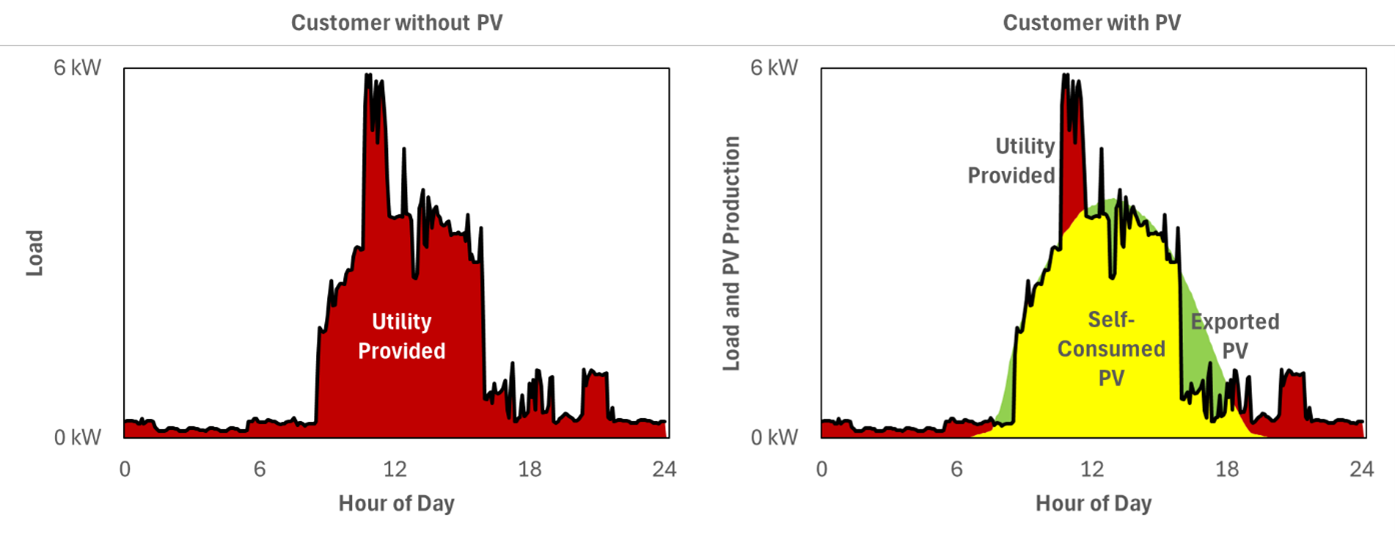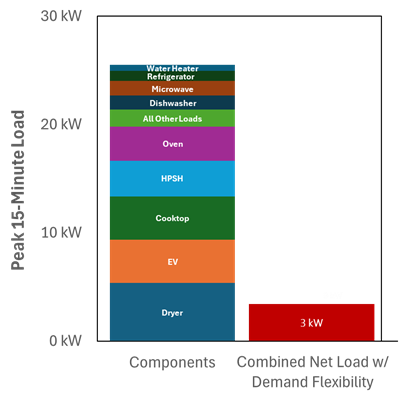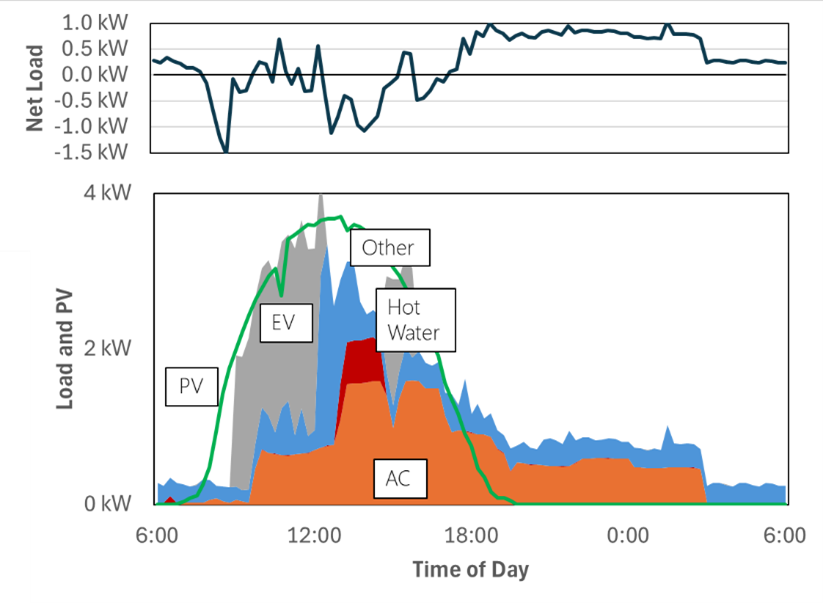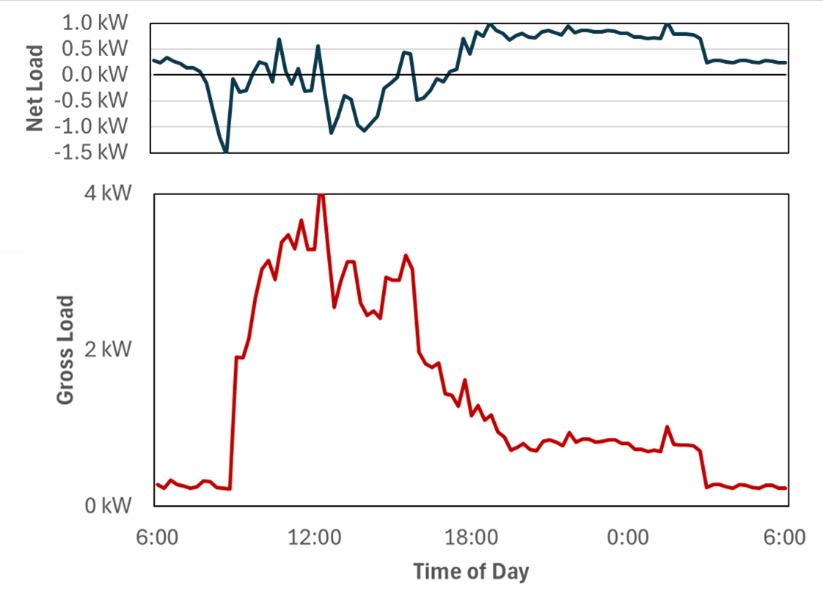As transportation and homes electrify, electricity consumption increases, energy demand rises and the grid is stressed. Many believe costly distribution system upgrades and higher rates are the only solutions.
Are distribution system upgrades the only way to address the impact of electrification, or can utilities and energy agencies encourage customers to reduce peak energy demand? In this article, we’ll discuss how residential customers with solar PV can use scheduling and demand flexibility to transform grid stress into opportunity—benefitting all customers.
Rethinking peak demand: The promise of demand flexibility
Electrification is often seen as a cycle: electricity usage grows, peak demand climbs and the utility must strengthen the grid, often at great expense. Demand flexibility offers a way to break this cycle. Demand flexibility is the ability for customers to adjust or shift electricity consumption in response to supply conditions, price signals or grid needs.
For customers with PV systems, we can apply an innovative approach to demand flexibility. The specific application of demand flexibility to PV customers is “self-consumption.” By self-consumption, we mean intelligently scheduling self-consumption of PV generation and minimizing electricity use during non-solar hours. When done thoughtfully and proactively, customers can dramatically reduce stress on the grid—without sacrificing comfort or convenience.
Figure 1 illustrates what we mean by PV self-consumption. Each graph represents the same customer’s load over the course of a day under two different scenarios: customer has no PV (left graph) and customer has PV (right graph). For the customer without PV, the utility provides all consumed energy.
If the customer adds PV, however, the situation is quite different, as illustrated in the graph on the right. In this scenario, the utility provides only a portion of the customer’s energy (red area). The customer directly “self-consumes” a portion of PV production (yellow area), and excess PV production is exported to the utility (green area).
Figure 1: Illustration of self-consumption for a customer without and with PV

Smart scheduling: Maximize solar consumption and minimize grid impact
What does demand flexibility implemented as self-consumption look like in practice? It means harnessing smart technologies and scheduling strategies to shift energy use to periods when solar production is high. Consider these practical steps for fully electrified homes with solar power:
- Pre-cool home during daytime solar hours
- Heat water midday
- Charge EVs using excess solar generation
Case study: A fully electrified home in Napa, CA
Consider this real-life example: A Clean Power Research® team member has a 2,900 sq. ft., fully electrified home in Napa, California. It’s equipped with PV, but not a battery. The self-consumption strategy described above was started in February 2025 and used to operate the home for more than six months.
To measure the impacts of the self-consumption strategy, the maximum 15-minute load of each individual device was analyzed and is shown in Figure 2. In addition, the maximum, coincident 15-minute load of all devices—including the solar PV system combined with demand flexibility—was analyzed. We found that the sum of individual device peak loads was 25 kW, but maximum net load with PV and self-consumption was 3 kW.
Figure 2: On-site solar combined with self-consumption reduces peak net load

Results: Dramatic reduction in peak net load
While this is a good result, the home’s performance on a particularly hot day was even more impressive. August 21, 2025 was the hottest day during the test period. Despite outdoor temperatures reaching 100°F, the home stayed comfortable between 67°F and 71°F thanks to pre-cooling. All day, the residents worked from home, cooked, ran appliances, heated water, charged an EV and even accommodated a contractor’s frequent visits.
Remarkably, as shown in Figure 3, the home’s net load never exceeded 1 kW even with all these activities occurring on a peak-load day. The AC was set at 69°F for all hours except the evening (5 pm to 9 pm), when the thermostat was increased to help reduce peak load. A smart switch scheduled water heating to occur in the middle of the day. And EV charging consumed excess solar production.
Figure 3: Net load, PV, and load components on hot day of the year

Transforming grid management: Opportunities for utilities
The benefits of self-consumption and demand flexibility go beyond individual homes. They offer utilities powerful tools to manage stress on the grid. By combining net load data and installed PV information, utilities can reconstruct gross load. This is possible today using PowerClerk®, a workflow automation platform, in combination with FleetView®, a data analytics platform, both available from Clean Power Research. As shown in Figure 4, the information from PowerClerk enables utilities to simulate PV production, then add it back to net load to calculate gross load.
Figure 4: Gross load reconstruction from net load & PowerClerk

Utilities can take several actions:
- Educate solar customers about the benefits of self-consumption
- Financially motivate solar customers to adopt smart scheduling devices and habits
- Design rate structures that reward self-consumption
- Launch targeted incentive programs to maximize grid benefits
Conclusion: Building a resilient, electrified future
Utilities and consumers face challenging decisions as electrification accelerates. The good news is that demand flexibility, especially through PV self-consumption, offers a clear path to managing peak load, reducing grid stress and even keeping rates in check. Fully electrified homes with solar can stay comfortable, active and environmentally friendly without overwhelming the grid—if we embrace smart scheduling and incentivize thoughtful energy use.
The future of energy is not just more electricity—it is more intelligent energy consumption. By reimagining how we use power, we can build a resilient, efficient and sustainable grid for everyone.
Contact us to schedule a FleetView demonstration or trial tailored to your needs.
